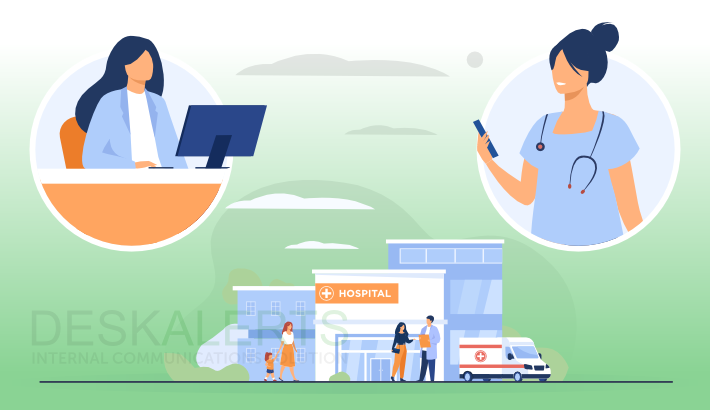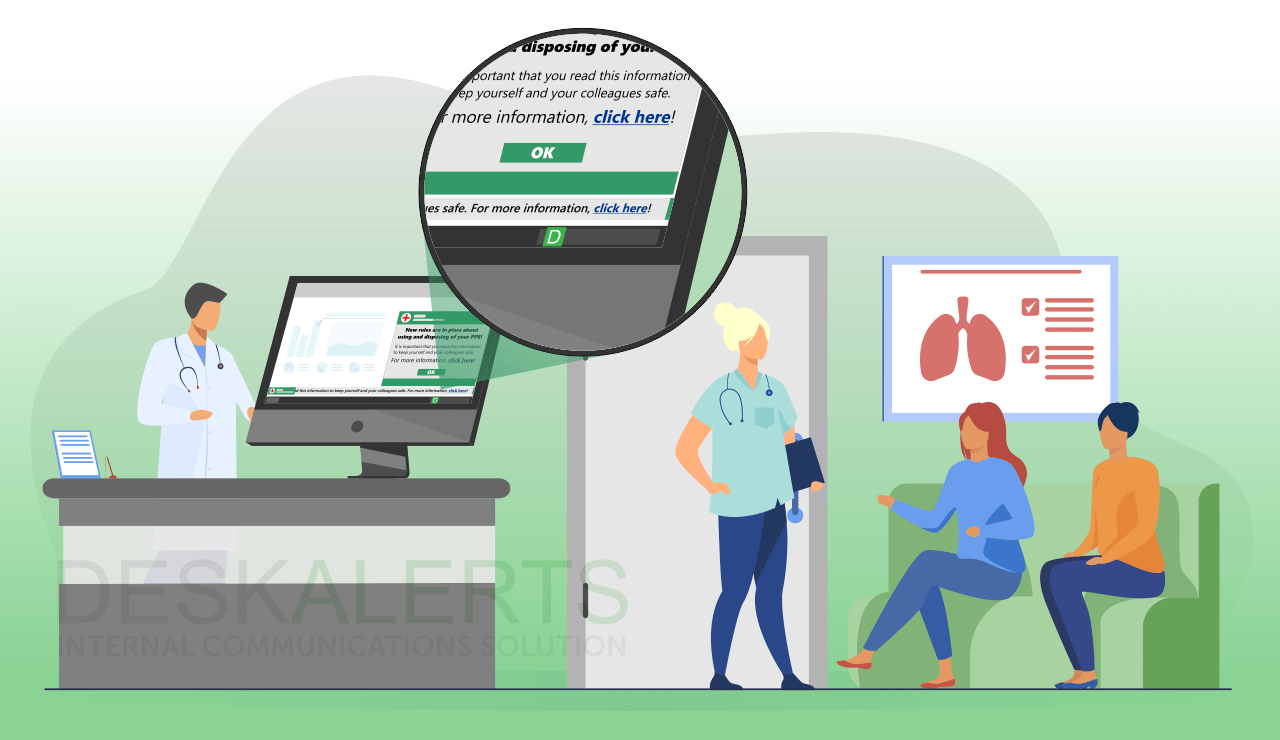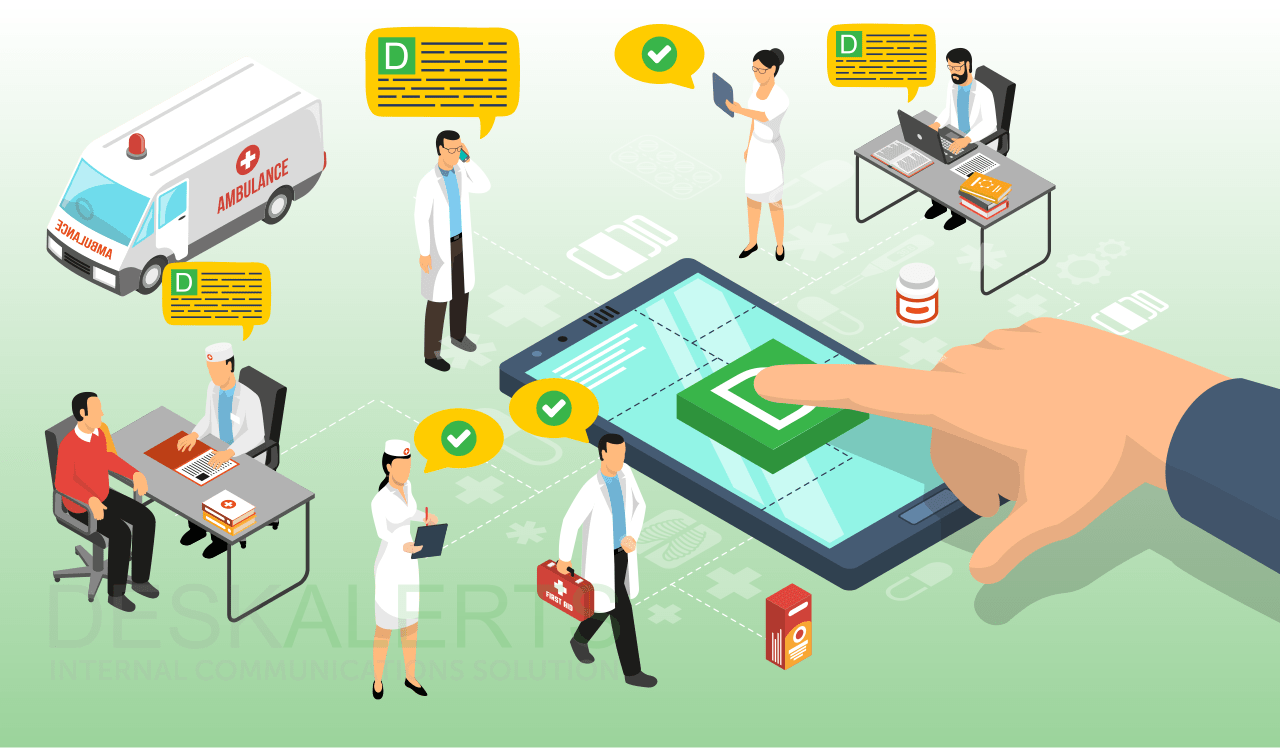
Advances in technology have brought improvements to all sorts of communications systems - and nurse communication systems in healthcare are no exception. A rapid uptake of new and emerging technologies provide nurses with ways to communicate with colleagues in more reliable and efficient ways than ever before - leading to smoother operations in the hospital, and better outcomes for patients.
Table of contents
What Are Nurse Communication Systems?
Challenges of Internal Communication in Medicine
How to Strike the Right Balance in Nursing Communications
Additional Features Available in Modern Nurse Communication Systems
Why Customized Solutions for Nurse Communication are on the Rise
The importance of correct integration in nurse communication systems
The role of smartphone connections in nurse communication systems
The Benefits of DeskAlerts Software in Healthcare
What Are Nurse Communication Systems?
Nurse communication systems is a term used to describe the various tools, technologies and protocols used to enhance communication within nursing teams and with other healthcare professionals.
These systems function to:
- Facilitate the timely exchange of important information such as patient assessments, care plans and updates on resources in a way that reduces the risk of delays or errors.
- Promote collaboration across different departments in a hospital, enabling nurses to seamlessly communicate with doctors, pharmacists and allied health professionals.
- Provide better care coordination across the healthcare service and ensuring continuity for patients.
- Enhance positive outcomes for patients by ensuring critical information among staff is communicated promptly and accurately. This can help to prevent adverse events and reduce medical errors.
- Increase operational efficiencies by streamlining the hospital or healthcare service’s communication processes, freeing nursing staff up to focus more time and effort on direct patient care activities.
Challenges of Internal Communication in Medicine
Healthcare is one of the most challenging sectors for internal communication, compounded by the fact that getting it wrong can have disastrous consequences for patients.
One of the most significant challenges is the complexity of healthcare systems themselves. They often include multiple departments, specialties and locations with teams working across different shifts throughout the day. Coordinating communication with these settings can be difficult and can lead to delays in information being shared and therefore potential errors in patient care.
Healthcare organizations also need to adhere to strict regulations around data security and patient privacy which can add complications to the use of certain communication channels like emails or messaging apps. Hospital administrators need to ensure they strike the right balance between facilitating effective communication while also complying with the relevant regulations and laws in their jurisdiction.
Outdated communication technologies like pagers, fax machines and paper-based record-keeping systems are still in use across many healthcare services as this sector has been very slow to adopt digital transformation in the same way as other sectors in the community. These systems can be inefficient and prone to errors, and fail to integrate with other technologies and workflows in use within a hospital.
Operating in high-stress environments and working long hours can also lead to healthcare staff having communication breakdowns and misunderstandings. It can be an additional challenge to find ways to circumvent this and to establish an internal culture where effective communication is both encouraged and valued.
The consequences of hospitals and healthcare organizations having inadequate internal communication can be severe: there are impacts on patient safety, quality of care and overall organizational performance to consider.
- Poor internal communication can lead to misunderstandings, missed information and delays in care delivery, increasing the likelihood of medical errors and adverse events.
- Communication breakdowns within healthcare teams can result in delays in diagnosing and treating medical conditions.
- Poor internal communication can erode trust, collaboration and morale among healthcare professionals, leading to dissatisfaction and burnout - which in turn can affect their job performance and retention.
- Inadequate communication practices can expose healthcare organizations to legal and regulatory risks such as lawsuits, fines, and sanctions.
- There are also financial implications for healthcare organizations, including increased costs associated with medical errors, litigation expenses and penalties for non-compliance with regulatory requirements. A Harvard University study found that 30% of medical malpractice suits were caused by communication issues, coming at a cost of $1.7 billion to the organizations involved and the unfortunate deaths of 1700 patients.
- Poor communication in hospitals has become so ingrained in staff experience that many of them actually just expect it will occur according to another study cited in Patient Safety and Quality: An Evidence-Based Handbook for Nurses.
“This culture, in which health care workers have come to expect faulty and incomplete exchange of information, leads to errors because even conscientious professionals tend to ignore potential red flags and clinical discrepancies. They view these warning signals as indicators of routine repetitions of poor communication rather than unusual, worrisome indicators.”
How to Strike the Right Balance in Nursing Communications
Advances in nurse communication systems make use of technology and integrate with medical systems, medical devices, real-time locating services and Internet of Things enabled devices.
They perform a host of different functions and can be introduced to replace outdated technologies such as pagers and public address systems. Modern nurse communication systems use text, apps, messaging functions, video conferencing and voice recognition to keep nurses connected to other staff while they’re on the go in the hospital environment.
This means that they are more connected than they have ever been before… but this can also pose some challenges. In a world where nurses are already surrounded by various machines and equipment and patient call systems that send them “beeps” and other notifications, these nurse communication systems can sometimes add to the noise.
Caryn Hewitt, RN, CNEO, CPHQ who is the senior director for consulting services at CenTrak in Newtown Pennsylvania discussed the challenges of finding the right balance between constant communication and alarm fatigue in Health Facilities Management Magazine.
“Health care facilities often leverage multiple messages coming from disparate systems instead of one connected platform,” she told the magazine. “While this level of visibility is beneficial, targeted communications that go directly to the right caregiver can mitigate exposure to an excessive number of alarms and subsequent desensitization to important messages.”
Best practice in this area, therefore, involves consolidating systems, ensuring interconnectivity and ensuring systems have easy-to-use and intuitive interfaces that reduce steps and save time for nursing staff.
Additional Features Available in Modern Nurse Communication Systems
Many nurse communication systems on the market today have a range of additional features that are worth considering.
This can include:
- Wearable tech
- Voice activation that encourages hands-free communication
- Two-way video conferencing between care teams
- Enhanced security where confidential information automatically self-destructs after a designated time period
- Innovative interactions with wifi enabled devices.
Why Customized Solutions for Nurse Communication are on the Rise
Customized solutions for nurse communication systems are becoming increasingly sought after in hospitals and other healthcare settings because they help to optimize efficiencies, improve overall workflow and enhance patient care.
Every healthcare facility has its own unique challenges, workflows, systems and communications needs which means that off-the-shelf nurse communication systems might not adequately address their specific requirements.
Customized solutions, on the other hand, can be tailored to provide the exact needs of the facility and incorporate various functionalities and features to streamline communication processes and adapt to existing workflows seamlessly.
A customized solution can integrate with existing technologies, meaning burses can communicate efficiently with other staff members - particularly when they are pressed for time in urgent situations.
Some custom nurse communication solutions can be designed in a way that align with individual preferences and workflows of nursing staff which increases take up rates and satisfaction with the system.
The importance of correct integration in nurse communication systems
When it comes to integrating nurse communication systems with other systems within a hospital, it’s of the utmost importance to ensure the integration is done properly to ensure seamless collaboration, efficient workflows and, ultimately, optimal patient care.
Integration facilitates the flow of critical information within the hospital so that decisions can be made in real-time. It also helps to reduce duplication of efforts and minimize errors by automating some processes and ensuring consistent data across various systems.
Basically, integration helps to streamline things so that everyone is on the same page with information.
Rhonda Collins, the chief nursing officer at Vocera in San Jose California, told Health Facilities Management Magazine that when all communication is runthrough an integrated platform, that system will be aware of the number of texts, alerts and other notifications each individual staff member has received over a certain time period and can appropriately redirect communications to more appropriate staff members.
“If a nurse is responding to a Code Blue, for example, they should not receive calls, messages, alerts or alarms until the code is completed,” she said. “An integrated communication system helps reduce alarm fatigue, speed up staff response times, and improve patient care, safety and experience.”
The role of smartphone connections in nurse communication systems
Smartphones have helped to revolutionize how healthcare professionals collaborate and coordinate patient care. They’re another example of successful integrations with systems that can benefit communications in hospitals.
Smartphones offer mobility and enable nurses to communicate from anywhere within a healthcare facility. This flexibility means there can be quick responses to patient needs and timely consultations between colleagues.
Smartphone connections provide instant communication capabilities through various channels such as voice calls, text messages, and secure messaging apps. Nurses can quickly reach out to physicians, specialists, or other team members for consultations, updates on patient conditions, or urgent interventions.
They also provide access to clinical information and resources at the point of care: nurses can access medical apps and reference materials directly from their smartphones, which empowers them with the information they need to make informed decisions.
The Benefits of DeskAlerts Software in Healthcare
At DeskAlerts, we understand the challenges when it comes to nurse communication. We count numerous hospitals and healthcare organizations around the world in our client list, and we have helped them to customize solutions to work specifically within their environments.
DeskAlerts is an internal communication software solution that is installed on employee devices including desktops, laptops, smartphones, tablets and digital screens. There are numerous benefits when it is implemented in a healthcare setting.
Some of the key advantages of DeskAlerts for nurse communication include:
- Instant communication
DeskAlerts enables you to communicate instantly with healthcare staff, no matter where they are located. It helps to break down silos between different departments, and ensures you can keep in touch with anyone who is on the go and not at a desk. The system works by sending desktop alerts, pop-up notifications, mobile alerts, scrolling ticker-tapes and more so that nurses, physicians, support staff and administrators receive important information in real-time.
- Emergency preparedness
An emergency situation can engulf a healthcare organization at any moment, with staff needing to respond quickly. DeskAlerts can be used to facilitate emergency preparedness by quickly communicating about the situation to the right people, at the right time through audience segmentation. This allows you to mobilize resources in a crisis such as a security incident, mass casualty event or a natural disaster.
Emergency alerts can also be sent to all staff instantly as part of the activation of emergency protocols so everyone can be aware of the situation and take the appropriate steps required of them.
EMERGENCY ALERT SYSTEM FOR BUSINESS
- Help with coordination and scheduling of staff
DeskAlerts integrates with your hospital’s Active Directory system and lets you communicate with all staff at once, groups of employees such as all pharmacists, all nurses on a particular ward or even just single employees.
Managing shifts and schedules can be complex, especially when they change at short notice. With DeskAlerts you can message someone if there’s been a shift change or you need them to attend an important meeting or training session. You can also send with acknowledgment requirements so there are no excuses from staff who might claim they missed a message.
- Acknowledgment of policies, procedures, protocols and regulations
Hospitals and healthcare organizations operate within complex legal and regulatory frameworks that are often subject to change as new laws are made or amended. It can be hard for staff to keep up with this information, and harder still for management to know for sure if the people on the ground understand their new responsibilities.
DeskAlerts can be used to send information to staff about important policy or regulatory changes and requirements in a way that can’t be skipped, ignored or missed. These can also be sent with acknowledgment requirements.
COMPLIANCE COMMUNICATION
- Education and training
Continuous education and professional development is important in the healthcare sector as professionals need to stay updated with the latest in medical advancements, procedures, protocols and best practices.
You can use DeskAlerts to deliver education materials directly to staff such as training modules or information updates. This includes by sending video content or links to HTML resources.
EMPLOYEE TRAINING SOFTWARE
- Employee engagement
Employee engagement is very important in healthcare because it helps to promote morale, productivity and retention. Poor communication is often a contributing factor to low levels of staff engagement. In addition to improving communication, DeskAlerts has tools and features specifically designed to help improve with engagement among staff. This includes the ability to send surveys, polls and quizzes to facilitate two-way communication and for management to receive feedback from staff on the ground in real-time.
BEST EMPLOYEE ENGAGEMENT ACTIVITIES IN HEALTHCARE
- Works on any device
DeskAlerts can be installed on any employee device and comes in versions that are suitable for Windows, Mac OSX, Apple ios and Android.
- Can integrate with other systems
DeskAlerts is scalable and customizable and can be integrated with a range of other systems that are in use within your hospital, such as color codes or paging services.
SEE ALL DESKALERTS INTEGRATIONS
***
Prioritizing nurse communication in your hospital is crucial to ensuring a better experience for both staff and patients alike. By leveraging DeskAlerts, you can enhance your internal communication efforts and make them more efficient. Get in touch with our experts today for a free demo showcasing how DeskAlerts can be used in your hospital.
 Caroline Duncan
Caroline Duncan







